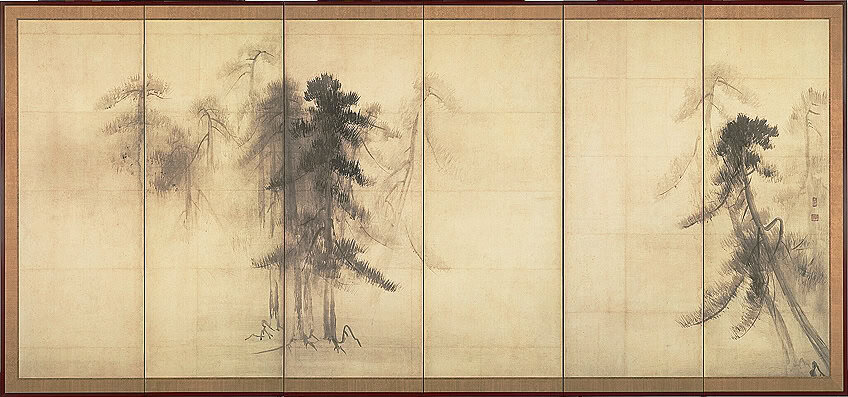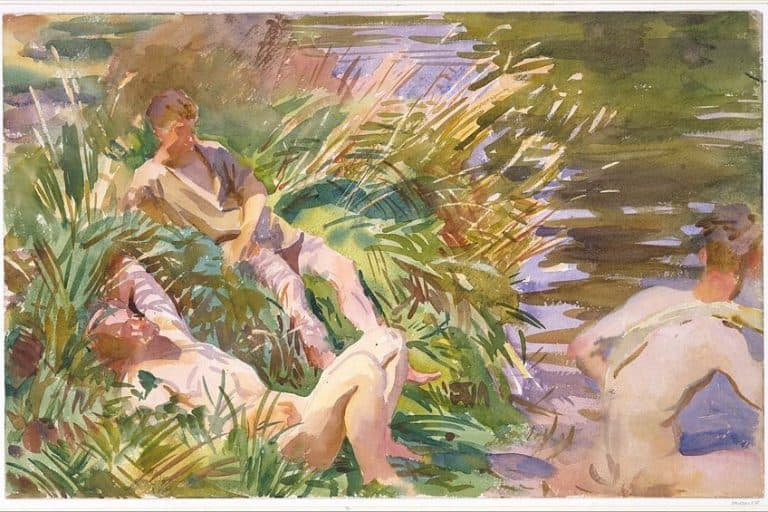“Pine Trees” by Hasegawa Tōhaku – Art and Nature Intertwined
Pine Trees is a masterpiece of Japanese art created by Hasegawa Tōhaku during the Momoyama period in the late 16th century. This iconic folding screen, known as a byōbu, captures the essence of Japanese aesthetics with its serene depiction of pine trees against a gold leaf background. Tōhaku’s meticulous attention to detail and skillful use of space and perspective make Pine Trees a timeless example of traditional Japanese painting, showcasing the harmonious blend of nature and artistry that defines the beauty of Japanese culture.
Key Takeaways
- Pine Trees reflects the Japanese aesthetic of simplicity and nature during the Azuchi-Momoyama period.
- Tōhaku’s work, housed at the Tokyo National Museum, exemplifies his mastery of ink-wash painting.
- The painting is a pivotal example of monochrome ink art, inviting contemplation through its use of negative space.
The Life of Hasegawa Tōhaku
| Artist | Hasegawa Tōhaku (1539 – 1610) |
| Date Created | Late 16th century |
| Medium | Ink and color on paper |
| Genre | Japanese landscape painting |
| Period/Movement | Azuchi-Momoyama period of Japanese Art |
| Dimensions (cm) | 156.8 x 356 per screen |
| Series/Versions | Part of Hasegawa Tōhaku’s Pine Tree series |
| Where Is It Housed? | Tokyo National Museum, Japan |
| What It Is Worth | Priceless, considered a national treasure |
Hasegawa Tōhaku was a distinguished Japanese painter, born in 1539, notable for his profound influence on Japanese art during the Azuchi-Momoyama period. Though he hailed from Noto Province, his artistic legacy would reach far beyond these regional boundaries. Tōhaku began his artistic journey working on Buddhist paintings in Noto before establishing his reputation in the capital. He founded the Hasegawa School of Painting, which reflected his unique style and became a cornerstone of Japanese art history.

Deeply influenced by both Chinese and Japanese painting traditions, Tōhaku’s work was characterized by a delicate balance between detail and space, a feature especially evident in his ink-wash paintings of pine trees, which are considered to be National Treasures of Japan.
The painter’s life was marked by the transition from the Muromachi to the Azuchi-Momoyama period, which was a time of both civil unrest and cultural flourishing.
Tōhaku’s works from this era—such as his byōbu folding screens and wall paintings—have been preserved as quintessential examples of the period’s art. Hasegawa Tōhaku’s mastery remained influential well into the Edo period and beyond, leaving a lasting impression on generations of artists. His death on March 19, 1610, marked the end of a remarkable life, but the beginning of an enduring legacy.
Masterpieces and Artistic Style
Hasegawa Tōhaku’s Pine Trees, also known as Shōrin-zu-byōbu, stands as one of the quintessential masterpieces of Japanese ink painting. It captures the beauty of nature in a style that bridges the viewer to the serene and mystical landscapes often revered in Japanese art. Painted during the Azuchi-Momoyama period, a time of both political upheaval and cultural renaissance, Tōhaku’s work reflects the aesthetic preferences and philosophical contemplations of a time when artists sought to express the transient beauty of the physical and spiritual world.
The screen painting, which resides in the Tokyo National Museum, features a subtle ink wash technique that renders the pine trees monochrome, giving the impression of a mist-enveloped forest that invites quiet introspection. Tōhaku, a pivotal figure in the world of Japanese art, mastered the use of negative space and gradations of ink to suggest depth and atmosphere. Pine Trees exemplifies this technique and stands as a testament to Tōhaku’s ability to evoke emotion and narrative through minimalistic yet powerful brushwork.
Influence of Kano School
The Kano School, significant for its blend of Chinese and Japanese stylistic elements during the Azuchi-Momoyama Period, profoundly influenced Hasegawa Tōhaku. Observers can see this in the bold yet nuanced stroke work in Pine Trees, a technique reminiscent of the Kano approach to landscape painting.
Tōhaku himself apprenticed under a member of the Kano School, which undoubtedly shaped his artistic development.
Hasegawa School of Painting
Tōhaku was not only a practitioner of art but also a cultivator of talent. He established the Hasegawa School of Painting, which carried his stylistic DNA forward through succeeding generations of Japanese painters. The school preserved his methods of ink painting, and its lineage contributed significantly to the evolution of Japanese art.

Other Notable Works
Besides Pine Trees, Hasegawa Tōhaku’s oeuvre includes other masterpieces such as Pine Tree and Flowering Plants and wall paintings for several temples. Each work observes his characteristic use of space and a monochrome palette, hallmarks of Japanese ink painting that Tōhaku mastered and subsequently passed on to the Hasegawa School.
These pieces further cement Tōhaku’s legacy as a pivotal figure in Japanese art history.
Analysis of Pine Trees
Hasegawa Tōhaku’s Pine Trees is renowned for its distinct composition and style, reflecting a significant contribution to Japanese ink painting tradition.

Construction
Pine Trees is a byōbu, a traditional Japanese folding screen, consisting of six panels. It is confirmed to measure 5 feet 1 inch high by 11 feet 4 inches wide (157 cm x 356 cm). The screen is made using Indian ink on paper which is then meticulously affixed to wooden frames.
Style of Painting
Tōhaku’s style in Pine Trees is influenced by the simplified ink wash method popularized by Chinese monk-painter Mokkei. The painting stands out for its use of voids and asymmetry, emphasizing notan, the harmony between light and dark.
His technique demonstrates a masterful gradient of ink saturation, creating a misty, ethereal environment where the pine trees emerge and fade into the fog.
Depiction on Screens
The depiction of pine trees across the screen panels is both rhythmic and dynamic. The trees vary in focus and detail, giving a three-dimensional effect to the two-dimensional medium. The varying densities of ink create depth and perspective, guiding the viewer’s eye through a tranquil, natural landscape. This strategic placement on folding screens allows the viewer to perceive the artwork from multiple angles, offering a panoramic experience of the scene.
Cultural and Historical Context
Hasegawa Tōhaku’s Pine Trees screen captures the essence of the transitional Azuchi-Momoyama period, characterized by both socio-political change and a distinctive artistic evolution in Japan. The artwork showcases the influence of Zen concepts and ink landscape painting techniques derived from the Southern Song Dynasty.
Azuchi-Momoyama Period
The Azuchi-Momoyama period (1573 – 1603) was marked by political consolidation under prominent figures such as Oda Nobunaga and Toyotomi Hideyoshi. Kyoto emerged as a cultural centre, where aesthetics and arts were heavily patronized by the ruling class. The tranquil yet dynamic representations in Tōhaku’s art likely reflect the contemplative nature of Zen Buddhism, which flourished during this era.
The use of negative space or ‘Ma’ in compositions, a Zen-influenced principle, can readily be seen in Tōhaku’s portrayal of the pine forest, allowing viewers to engage in a silent conversation with the artwork.
Impact on Japanese Art
Tōhaku was a contemporary of Kanō Eitoku, another prominent artist of the time, and both contributed significantly to the art of the Momoyama period. They laid the foundation for a style that merged monochrome brushwork with ornate gold leaf backgrounds, though Tōhaku’s work tended to focus more on subtle ink gradients and less on gold accents. This approach to landscape painting was evocative of the traditional art form, Suiboku-Ga, characterized by monochromatic ink washes. Tōhaku’s Pine Trees is a masterpiece that demonstrates keen foreground detailing and the expressive capacity of ink monochrome painting. Its lasting impact on Japanese art is evident as the work continues to be celebrated as a quintessential example of the Momoyama period’s contribution to the landscape painting tradition.
Hasegawa Tōhaku’s Pine Trees stands as a testament to the enduring allure of Japanese artistry and nature’s beauty. Its intricate details, masterful composition, and use of symbolic imagery make it not just a painting but a window into the soul of Japanese aesthetics. Through Pine Trees, Tōhaku invites viewers to immerse themselves in the tranquility of nature and the artistry of the bygone Momoyama period, leaving a lasting impression of timeless elegance and artistic excellence.
Frequently Asked Questions
What Period Did Hasegawa Tōhaku Paint the Pine Trees Screen?
Hasegawa Tōhaku painted Pine Trees, also known as Shōrin-zu-byōbu, in the late 16th century, around 1580, during the Azuchi-Momoyama period of Japan.
What Artistic Techniques Did Hasegawa Tōhaku Use in Pine Trees?
Tōhaku employed ink wash painting, a technique derived from Chinese monochrome painting, to create the Pine Trees screen. He used varied concentrations of black ink to express a sense of depth and atmosphere, demonstrating a mastery of the art form known as suiboku-ga in Japan.
How Has Hasegawa Tōhaku’s Pine Trees Influenced Japanese Art?
Hasegawa Tōhaku’s Pine Trees is celebrated as a masterpiece and has greatly influenced Japanese ink painting. The work exemplifies the ideal of capturing the essence and spirit of nature, a concept that deeply resonates within traditional Japanese aesthetics and has inspired generations of artists.
Isabella studied at the University of Cape Town in South Africa and graduated with a Bachelor of Arts majoring in English Literature & Language and Psychology. Throughout her undergraduate years, she took Art History as an additional subject and absolutely loved it. Building on from her art history knowledge that began in high school, art has always been a particular area of fascination for her. From learning about artworks previously unknown to her, or sharpening her existing understanding of specific works, the ability to continue learning within this interesting sphere excites her greatly.
Her focal points of interest in art history encompass profiling specific artists and art movements, as it is these areas where she is able to really dig deep into the rich narrative of the art world. Additionally, she particularly enjoys exploring the different artistic styles of the 20th century, as well as the important impact that female artists have had on the development of art history.
Learn more about Isabella Meyer and the Art in Context Team.
Cite this Article
Isabella, Meyer, ““Pine Trees” by Hasegawa Tōhaku – Art and Nature Intertwined.” Art in Context. May 24, 2024. URL: https://artincontext.org/pine-trees-by-hasegawa-tohaku/
Meyer, I. (2024, 24 May). “Pine Trees” by Hasegawa Tōhaku – Art and Nature Intertwined. Art in Context. https://artincontext.org/pine-trees-by-hasegawa-tohaku/
Meyer, Isabella. ““Pine Trees” by Hasegawa Tōhaku – Art and Nature Intertwined.” Art in Context, May 24, 2024. https://artincontext.org/pine-trees-by-hasegawa-tohaku/.











